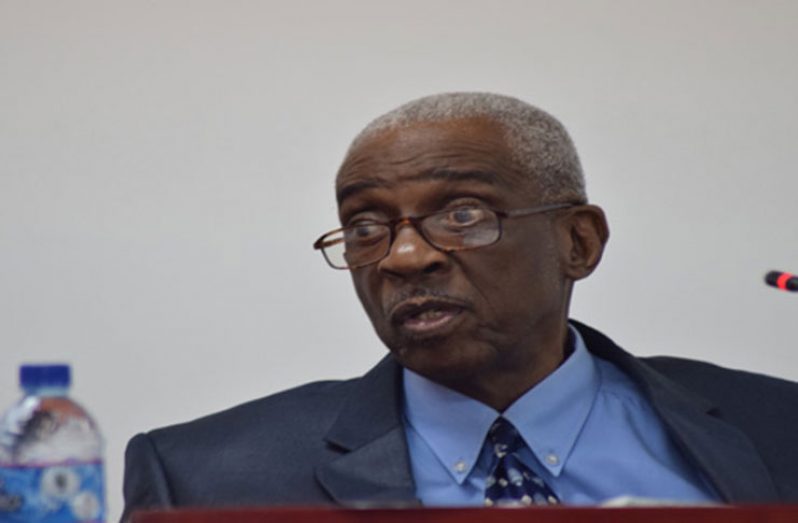In the aftermath of Sunday’s devastating fire at the Camp Street Prison, Justice James Patterson said the area should be transformed into an emergency remand centre.
Patterson a retired judge who chaired the Commission of Inquiry (COI) into the Camp Street prison riot that claimed 17 lives following a fire on March 3, 2016, spoke with Guyana Chronicle exclusively on Monday. “Perhaps the Government might think about clearing up the debris in Camp Street and making that an emergency remand centre,” Justice Patterson told this newspaper. According to him, the prisoners on remand should not be sent to the various prisons across the country but should be held at the remand center. “This is something Government may want to consider,” he said, until the required resources are acquired for the construction of a new prison.
Guyana’s Public Security Minister Khemraj Ramjattan said it may take the Government three years to have a new prison in place but while three years may be considered too long for some, Justice Patterson believes that certain factors must be taken into consideration.
“Three years is almost too long but we have to understand the Administration is labouring under tremendous financial constraints. You can’t expect them to achieve in a year or even two, what hasn’t been done since the turn of the century. We have been having prison reports since the early 2000s.” Through his eyes, the Administration has been trying to do its best.
On Sunday, when Camp Street Prison was set ablaze, the more than 1000 prisoners, who were housed in the country’s primary penitentiary, were reportedly safely evacuated. It was not long before they were transferred to various holding areas. Five prisoners, however, escaped during the initial stage of the inferno.

Nevertheless, by Monday a decision was taken to have bail granted to petty crime offenders, and while Justice Patterson believes this is a positive step, he bemoaned the common practice of remanding prisoners for petty crimes.
However, Justice Patterson said he is cognisant of the steps being taken to reform the country’s judicial system. “There is a lot of work being done right now. The President of the Caribbean Court of Justice (CCJ) has been very instrumental. He has been coming here quite often and giving assistance and doing something positive about it,” the retired judge said.
Reflecting on the tragedy that struck the nation on Sunday, Justice Patterson said he was “devastated” when he received word that the Camp Street Prison was on fire, and a prison officer had been killed, and others injured.
“I wondered if our recommendations were not strictly observed but then time is important,” Justice Patterson said, while noting that enough time had not elapsed since the March 3, 2016 inferno. Though, a life was loss,” it was clear that the Standard Operating Procedure (SOP) worked. “Only tragedy is that a life was lost but that is not through any fault of the administration, and the observing of the procedure in events like these.”
Not happy at all
Attorney Selwyn Pieters, who appeared as counsel for the Guyana Police Force (GPF) and the Guyana Prison Service (GPS) during the 2016 COI, said he was taken aback by the situation. “I was not happy at all. I was quite upset,” Pieters told Guyana Chronicle from his Ontario, Canada office.
“What happened at the prison on Sunday should not have happened,” he emphasised. Pieters noted that upon the completion of the COI, a menu of recommendations was put forth to Government. Some of those recommendations, he pointed out, stemmed from testimonies of the now Director of Prisons, Gladwin Samuels, other prison officers, and prisoners.
Primary among them raised by Samuels was the fact that the Camp Street Prison was a combination of wooden buildings. “Quite frankly that was a major consideration, one, that prisoners should not be housed in those wooden buildings and that a brick prison be built… Secondly the staff to inmate ratio would have been a problematic issue, Samuels spoke about that. In terms of the Brick Prison, all necessary steps should have been taken to open that prison that was still under construction at Brickdam,” he opined.
It was pointed out that at the time of the prison unrest in 2016; there were fewer prisoners in the penitentiary when compared to the recent inferno, although the issue of overcrowding had been primary concern. Before it was reduced to ashes, the Camp Street Prison housed 1018 prisoners, the majority of whom were on remand, although it was designed to accommodate just about 600 prisoners.
Disconnect in judiciary
For him, overcrowding is directly linked to an issue that lies within the judicial system. “Persons smoking a joint, persons with petty criminal activities are being incarcerated at the Georgetown Prison because these magistrates and these judges seem to be divorced from the realities of the prison. Perhaps we need to put them in the prisons and have them spend a week there, or their children, so they can appreciate the burden and the sort of risks that come with overcrowding,” the attorney said.

He said too its time the judiciary gets its act together. “Sometimes I think the judiciary is far removed from the reality of society,” Pieters lamented while positing that alternative sentences should be granted to persons with minor offences as against imprisonment. He believes that the situation further compounded when a decision was made to house high profile criminals at the Camp Street Prison along with prisoners who had committed minor criminal acts.
“You are dealing with a wood prison that is vulnerable and yet you have persons who were condemned to death for very very serious offenses. The Bartica Massacre was not a cup of tea and you have these men who are extremely dangerous not only to prisoners but prison officers themselves and society as a whole. Those men should not have been in a wooden prison.”
Resource allocation
Additionally, Pieters said while the Public Security Ministry has been playing with role and making the necessary recommendations, it is for the Government to act. “What I have a quarrel with is the resource allocations and the Minister spoke about that…obviously this Government has to take it serious. I spoke about those wood prisons in May, 2016.”
While representing the Guyana Police Force (GPF) and the Guyana Prison Service (GPS) during the COI, Pieters had worked closely with Prison Warder Odinga Wickham, who was shot during the riot. Wickham died while being treated at the Georgetown Public Hospital on Sunday.
Wickham’s death brought Pieters to tears. “I cried all night, because Mr. Wickham is somebody that I know and I worked with very closely,” he told this newspaper, while emphasising the prison officers worked under very difficult circumstances.
Despite the situation, Pieters said the prison officers ensured the prisoners were brought to safety. “It certainly speaks to the professionalism of the prison officers. It also speaks to the leadership, leadership comes from the top. So it shows that the leadership of the Prison Service was right in tune with the Standard Operation Procedures (SOPs), right in tune with what they needed to do to evacuate those prisoners safely and humanely out of that inferno and those officers must be commended,” Pieters said.




.png)










1 thought on “Make Camp St emergency remand centre-Justice Patterson”
Good suggestion by Justice Patterson…..maybe they should consider it………..